Evaluating effects of Dielectric Models on the surface soil moisture retrieval in the Qinghai-Tibet Plateau
Rong Liu,Xin Wang,ZuoLiang Wang,Jun Wen
1.Key Laboratory of Land Surface Process and Climate Change in Cold and Arid Regions,Northwest Institute of Eco-Environment and Resources,Chinese Academy of Sciences,Lanzhou,Gansu 730000,China
2.College of Atmospheric Sciences,Chengdu university of Information Technology,Chengdu,Sichuan 610225,China
ABSTRACT Based on the measurement of L-band ground-based microwave radiometer (ELBARA-III type) in the Qinghai-Tibet Plateau and the τ - ω radiative transfer model, this research evaluated the effects of four soil dielectric models, i.e., Wang-Schmugge,Mironov,Dobson,and Four-phase,on the L-band microwave brightness temperature simulation and soil moisture retrieval.The results show that with the same vegetation and roughness parameterization scheme,the four soil dielectric models display obvious differences in microwave brightness temperature simulation. When the soil moisture is less than 0.23 m3/m3,the simulated microwave brightness temperature in Wang-Schmugge model is significantly different from that of the other three models, with maximum differences of horizontal polarization and vertical polarization reaching 8.0 K and 4.4 K,respectively;when the soil moisture is greater than 0.23 m3/m3,the simulated microwave brightness temperature of Four-phase significantly exceeds that of the other three models;when the soil moisture is saturated,maximum differences in simulated microwave brightness temperature with horizontal polarization and vertical polarization are 6.1 K and 4.8 K respectively,and the four soil dielectric models are more variable in the microwave brightness temperature simulation with horizontal polarization than that with vertical polarization.As for the soil moisture retrieval based on the four dielectric models,the comparison study shows that,under the condition of horizontal polarization,Wang-Schmugge model can reduce the degree of retrieved soil moisture underestimating the observed soil moisture more effectively than other parameterization schemes, while under the condition of vertical polarization, the Mironov model can reduce the degree of retrieved soil moisture overestimating the observed soil moisture. Finally, based on the Wang-Schmugge model and FengYun-3C observation data,the spatial distribution of soil moisture in the study area is retrieved.
Keywords:L-band;microwave brightness temperature;soil dielectric model;soil moisture retrieval
1 Introduction
Soil moisture, as a key parameter in regional and global energy and water cycles,is one of the most important variables when it comes to research related to land, hydrology, agriculture, and climate (Seneviratneet al., 2010; Wenet al., 2011). The accuracy of soil moisture data directly affects the results of land surface and climate models simulating land-atmosphere water, energy, and carbon exchange (Entekhabiet al.,2010). Currently, in order to obtain more accurate data of soil moisture, researchers have carried out numerous scientific experiments, including single-site combined with network observation, ground-based,airborne, and spaceborne microwave remote sensing(Collianderet al., 2017). Recent studies have shown that the method of retrieving soil moisture based on the L-band (1-2 GHz) passive microwave is one of the most effective ways to obtain soil moisture data at the regional or global scale (Hilhorstet al., 2000;Wenet al.,2005;Wigneronet al.,2017).
The passive microwave radiative transfer model constitutes the theoretical basis of passive microwave remote sensing. In order to simulate the microwave brightness temperature of the underlying surface covered by vegetation, Moet al.(1982) assumed that the temperature of soil and the vegetation canopy are the same, and the microwave brightness temperature is equivalent to the microwave radiation directly emitted by the vegetation. The vegetation emitted microwave radiation after reflection by the ground, and the soil emitted microwave radiation after attenuation by the vegetation. The zero-order radiation transmission model is proposed by this hypothesis. The model is flexible and widely applicable. Therefore,τ-ωmodel has been applied to a variety of algorithms for soil moisture retrieval with passive microwave remote sensing,including the Soil Moisture and Ocean Salinity mission (SMOS)and Soil Moisture Active-Passive(SMAP)launched in recent years (Kenet al., 2012).The soil dielectric constant (εs), effective temperature(Teff), surface roughness (h) and vegetation optical thickness (τ) are key parameters for soil moisture retrieval with theτ-ωmodel, and the prerequisite is the difference between the dielectric constant of water(εw≈80) and that of dry soil (εr≈4) (Arconeet al.,2008). Thus, a reliable soil dielectric model is essential to retrieve high-quality soil moisture data.
It is very complicated to accurately describe the dielectric properties of soil. To this end, researchers have established a variety of soil dielectric models on the basis of theory and experiments (Behari, 2005).Wanget al.(1980) divided the soil moisture into bound water content and free water content based on a large number of experiments and built the Wang-Schmugge soil dielectric model which considered four media: soil matrix, air, bound water and free water. In the process of soil changing from dry to wet,the water molecules started to be adsorbed around the soil particles and could not move freely. That kind of water was called bound water.When the soil moisture continued to increase and exceeded a certain threshold, the water molecules could move freely, which was classified as free water. Because the dielectric constant of bound water was difficult to obtain,Wang-Schmugge model replaced the dielectric constant of bound water with that of ice, which simplified the computing process. However, as the model actually failed to reflect the dielectric properties of bound water, calculation error was introduced into the model at the same time (Partet al., 2017a). Dobsonet al.(1985) built a Dobson soil dielectric model based on the experimental data of 1.4-18 GHz, and combined with Birchak's (1974) principle of soil refractive index, built a semi-empirical soil dielectric model. Both the Dobson model and the Wang-Schmugge model divided soil moisture into bound water and free water,but the difference was that in Dobson model the contribution of bound water to the dielectric constant was represented by free water, and there was actually no calculation for the dielectric constant of bound water(Parket al., 2017b). In order to fully show the difference between the dielectric constant of free water and that of bound water,Mironovet al.(2004)built a general refractive index mixture model based on theoretical derivation, and combined the Debye equation to calculate the dielectric constants of both bound water and free water, which greatly distinguished the Mironov model from the above three models.The Debye equation was widely applied in the calculation of different kinds of dielectric constants as it clearly described the relationship between physical properties like the real part, imaginary part of dielectric constants,the dielectric loss tangent,and the frequency of alternating electric fields. Therefore, the Mironov soil dielectric model embodied the property of soil bound water's dielectric constant,and was one of the theoretical soil dielectric models currently available. Afterwards, Mironovet al.(2009, 2013a, 2013b) have made several improvements over the refractive index mixture model to promote its simulation accuracy,making the model more applicable. In a recent study,Mironovet al.(2017) combined temperature and soil texture to overcome the difficulty of soil moisture retrieval with the L-band (1.4 GHz) microwave for frozen soil (from -1 °C to -30 °C), and developed the Mironov soil dielectric model which could be applied to both frozen and thawed states of soil. Also, Stähliet al.(1997) carried out experiments based on Time Domain Reflectometry (TDR) to study the liquid water and solute transport in frozen soil, which divided the soil into four components: matrix, liquid water,ice, and air, and combined the soil temperature with the soil dielectric model, thus building the Four-phase soil dielectric model. The Four-phase model could also be applied to soil moisture retrieval for both frozen and thawed states soil. Since then, a number of studies have used this model for SMAP spaceborne and ELEBARA ground-based soil moisture retrieval of frozen and thawed soil,and obtained good retrieval results (Zhenget al., 2017, 2019). The difference between it and the other three dielectric models was that the Four-phase model did not distinguish between free water and bound water, but divided soil moisture into free water and ice. The above four soil dielectric models,in which the soil texture and other parameters for the calculation process were easy to obtain, were flexible and widely applicable, and have been widely used in the soil moisture retrieval from active and passive microwave remote sensing.
In summary, the applicability of the soil dielectric model is essential for obtaining high-precision soil moisture data. However, with different building backgrounds and methods, the current soil dielectric models are available under different conditions, and each has its own advantages and disadvantages. For the same soil, different soil dielectric models may obtain different dielectric constants. In order to improve the quality of soil moisture observation data in the Maqu region, an important water conservation area in the upper reaches of the Yellow River in China, and to provide basic support for the study of how soil moisture changes in this region affects the water cycle, climate change and ecologically sustainable development of the plateau, this paper uses observation data of the ground-based microwave radiometer (ELBARA-III type,L-band)in this area to evaluate the applicability of different soil dielectric models for soil moisture retrieval. Finally, the spatial variation of soil moisture in the source region of the Yellow River is proposed based on the Wang-Schmugge model and FengYun-3C observation data.
2 Research area, observation instruments and data
2.1 Research area
The observation experiment is carried out in the Maqu (33°54′N, 102°09′E), the core water conservation area of the Yellow River.As an important runoff of the Yellow River, this area provides 45.0% of water in the upper reaches of the Yellow River, so it is also called "the Reservoir of Yellow River". The average altitude of the research area is about 3,300 meters.The vegetation is mainly alpine grassland,and soil types are mainly silt loam and sand loam (Figure 1). It is the main water source in the upper Yellow River,and the marsh wetland in this area is one of the areas which contains the highest percentage of plateau peatlands in China, which is very important to the ecological environment and regional social economy of the upper Yellow River. The average annual precipitation from 1967 to 2017 in this area was about 604 mm, and the average annual temperature was about 2 °C, showing a semi-humid continental monsoon climate in the subfrigid zone of the plateau(Liuet al.,2019).
2.2 L-band microwave radiometer (ELBARA-III)
The ground-based microwave radiometer (ELBARA-III type, L-band) used in this research is the Dicke microwave radiometer (f=1.41 GHz,λ=21 cm)developed by the Swiss Federal Forest-Snow Institute for the European Space Agency (ESA). The radiometer is mainly used for pre-launch debugging of SMOS, and ground verification experiments after the satellite is in orbit, which helps to verify data from SMOS and improve the soil moisture retrieval algorithm as well as the passive microwave radiative transfer model using L-band satellite remote sensing(Schwanket al., 2010). Zhenget al.(2019) carried out the latest study that the ELBARA-III groundbased observation to verify the observational results of SMAP. ELBARA-III adopts the optimal design of dual-polarization (p = H, horizontal polarization, V,vertical polarization), tapered antenna (diameter, antenna length, and-3dB beam width were 1.4 m, 2.7 m and 12°, respectively), and two synchronized channels(1.400-1.418 GHz,1.409-1.427 GHz),which improves the function of identifying noise signals in the frequency band. It also comes with calibration of cold and heat sources to minimize signal interference and observation errors (Christianet al., 2003). The absolute error of ELBARA-III brightness temperature observation is less than 1.0 K, and it can sensitively respond to microwave brightness temperature changes greater than 0.1 K. In 2016, the Key Laboratory of Land Surface Process and Climate Change in Cold and Arid Regions of Chinese Academy of Sciences and European Space Agency carried out the scientific research cooperation on SMOS ground observation,and set up the L-band passive microwave radiometer ELBARA-III in the Maqu area. The ELBARA-III antenna faces south with an iron tower of 4.8 m as the installation platform, and the microwave radiometer itself has a height of 1.7 m, as presented in Figure 2a and Figure 2d. ELBARA-III carried out ground scan observation at an observation angle of 40° to 70° at 30-minute intervals and 5° angle steps. At the same time, it conducted observations of sky radiation at an elevation angle of 155° at 23:55 every day, to calibrate ELBARA-III's own cold source. In this evaluation study, the dual-polarized microwave brightness temperature observed by ELBARA-III at an observation angle of 50° from July 1, 2016 to August 20,2016 was selected.It also eliminated the effect of vegetation's water interception of radiation observation by comparing the data of weighing rain gauge T200B and that of the vegetation leaf hygrometer DLWS in the observation field. Figure 2e shows the field of view of ELBARA-III microwave brightness temperature observation. Based on the parameterization scheme developed by Pellarinet al.(2006),the contribution of atmospheric downward radiation to the ELBARA-III microwave brightness temperature observation during the study period was about 0.004-0.650 K,so this study ignored the influence of atmospheric downward radiation.
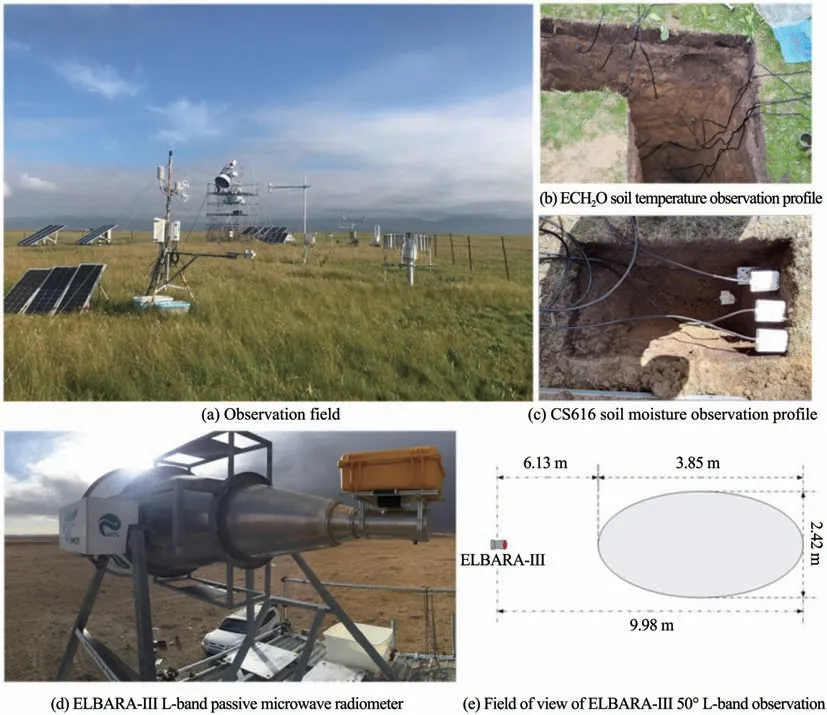
Figure 2 Overview of field data and L-band passive microwave remote sensing instrument used in this study
2.3 Soil temperature and moisture data
In this study, soil moisture observation used the CS616 soil moisture sensor produced by Campbell in the United States.The volumetric water content (VWC)observation resolution of the CS616 sensor was less than 0.1% m3/m3, and the observation data interval was 30-minute intervals. The vertical depth distribution of the observation profile is 2.0, 5.0, 10.0, 20.0 and 40.0 cm(Figure 1c).In order to obtain more accurate soil moisture data, thus ensuring that data used in this research is reliable, the soil moisture obtained by the CS616 sensor was firstly calibrated with the traditional drying and weighing method. Therefore,in this study, the soil moisture observation at 2.0 cm depth was selected as the true value of soil moisture during the study period for the brightness temperature simulation, and 2.0 cm and 5.0 cm of soil moisture observation were selected for analyzing the effect of soil dielectric models on the soil moisture retrieval using microwave brightness temperature.
The 5TM sensor and EM50 data collector produced by the American Decagon Company are used for the observation of temperature profile.The sensor accuracy is 0.1°C,the output interval of data is 30 minutes,the same as ELBARA-III, and vertical depth distributions for temperature profile observation are 5.0,10.0,15.0, 20.0, 25.0, 35.0, 45.0, 55.0, 65.0, 75.0, 100.0,and 150.0 cm,as presented in Figure 2b.
2.4 Vegetation parameters
The research of Zhenget al.(2019) shows that,for the grassland underlying surface on the Qinghai-Tibet Plateau, the parameterization scheme of vegetation optical thickness in the default retrieval algorithm of SMAP overestimated the vegetation's effects on the brightness temperature simulation and soil moisture retrieval. According to the discrete model simulation, it was found that the vegetation's leaf area index (LAI) and optical thickness (τ) showed a very good linear relationship (τ= 0.025·LAI),which was conducive to reduce the overestimation of vegetation's effects compared to SMAP's default retrieval algorithm. Based on this, the vegetation optical thickness of the grassland underlying surface on the Qinghai-Tibet Plateau could be obtained based on the actual observation of LAI, which came from the MODIS product of the same period (https://lpdaac. usgs. gov/dataset_discovery/modis/modis_products_table/). In order to obtain more reliable LAI data, this research sampled vegetation at multiple locations in the observation field on June 27, July 12,and August 17, 2016, and used the traditional "quadrat" survey to obtain the actual LAI data, which, after calibration and linear interpolation, finally came to consecutive LAI values in the study area (Heet al., 2007). In order to distinguish between vegetation temperature and soil temperature in theτ-ωradiative transfer model, the study took the temperature observed by the SI-111 infrared thermometer as the vegetation temperature. SI-111 is a surface infrared thermometer with an absolute error of ±0.2 °C from-10.0°C to 65.0°C.As the soil surface was completely covered by dense vegetation in the observation field, this study took the temperature measured by SI-111 as the vegetation temperature.
3 Methodology
3.1 τ-ω radiative transfer model
Theτ-ωmodel is the most widely used zero-order forward microwave radiative transfer model(Zhenget al., 2019). The microwave brightness temperature (TBp) in this model consists of three parts:the first part is the microwave radiation directly emitted by the vegetation, the second part is the vegetation-emitting microwave radiation after reflection by the ground, and the third part is the soil-emitting microwave radiation after attenuation by vegetation.The model is displayed as follows:

in which,ωprepresents the single scattering albedo of vegetation with different polarizations, and for grasslandω= 0.05.pis the polarization mode (p=H,horizontal polarization;p=V, vertical polarization),Tvis the effective temperature of vegetation,Γpis the vegetation transmittance of microwave with different polarizations,φis the observation angle of ELBARA-Ⅲ, andTsis the effective soil temperature.This research,based on the soil temperature observation profile from 5.0 cm to 150.0 cm, and combined with the effective temperature integral representation according to the radiative transfer theory,has developed the expression as follows (Royet al.,2017):

Ts(z) is the thermodynamic temperature at the depth (z), and the attenuation coefficient is related to the real part(ε')and imaginary part(ε'')of soil dielectric constant at that depth and observation wavelength(λ).The expression is as follows:

For the reflectivity of rough surface to different polarized microwavesrp, the calculation is as follows(Royet al.,2017):

where,andrespectively represent the reflectivity of the smooth surface to different polarized microwaves, in which (p=H,V;q=V,H), the reflectivity is an equation about the dielectric constant of the reflecting surface and can be obtained using Fresnel Equation,Qis the cross-polarization factor, andhis the roughness parameter, dimensionless unit. The latest research provided a new scheme for the value of some parameters in the model.Wigneronet al.(2011)described the relationship between the effective surface roughness parameter (h) and the root mean square height(SD)based on experimental data,and for this studySD= 15.6 mm. This empirical equation can be used in calculations related to microwaves from 1.4 to 90.0 GHz, thus applicable for a wider range of frequency,and its expression is as follows:

Wanget al.(1981) evaluated the model based on numerical simulation and proposed a new calculation method for the cross-polarization factor(Q):

and at the same time, provided a new parameterization scheme for the angle correction constant(N):

Zhenget al.(2018, 2019)compared the above parameterization scheme to the default parameterization scheme of SMAP based on SMAP and ELBARA-III observations, respectively, and found that the scheme of SMAP underestimated the impact of roughness length, while the above scheme could effectively reduce this underestimation. Therefore, this research adopts the above parameterization scheme to evaluate the dielectric model.
In the process of retrieving soil moisture based on theτ-ωradiative transfer model, the reflectivity of rough surface to different polarized microwaves (rp)described by Equation(5)is one of the important parameters, while the key to solving Equation(5)lies in the dielectric constant of the reflecting surface of electromagnetic wave. In this study, the reflecting surface is soil covered with vegetation, and the soil dielectric constant directly affects the calculation results of effective soil temperature. Therefore, the accuracy of soil dielectric constant plays an essential role in obtaining high-quality soil moisture.
3.2 Soil dielectric model
The real and imaginary parts of the complex permittivity quantitatively represent the storage and loss capacity of electromagnetic wave energy in the medium, and the soil dielectric constant determines the emission of electromagnetic wave when the microwave frequency and soil roughness are constant. The soil dielectric model is the most important way to describe the dielectric constant. At present, soil dielectric models mainly contain empirical, semi-empirical and physical models, but as the building background and method of each kind of model are different, the application scopes and calculation results vary accordingly. Therefore, this study is evaluates the effects of the following four soil dielectric models on the results of soil moisture retrieval using L-band passive microwave remote sensing.
3.2.1 Wang-Schmugge model
Wang and Schmugge (1980) analyzed the soil dielectric constant experimental data at a temperature of about 293.0 K and frequencies of 1.4 and 5.0 GHz, and found that for a certain composition of soil,the soil dielectric constant changed slowly with soil moisture when the soil moisture was within a threshold. After the soil moisture exceeded the threshold, the soil dielectric constant increased rapidly with an increase of soil moisture. At the same time, it was found that the contents of sand and clay had a significant effect on the change of soil dielectric constant. The critical value was used as the transition point(θt)between bound water (θbw) and free water (θfw). The soil dielectric model was established combined with the mixture of bound water, free water, air and soil matrix (Wanget al.,1980). When the soil moisture content (θc) is less thanθt,the soil dielectric constant can be expressed as:

whenθcis bigger thanθt,the soil dielectric constant is expressed as:

where, the soil porosity (P) is taken as 0.50 m3/m3,whileεa=1+0j,εr=5.5+0.2j,εw, andεi=3.2+0.1j, respectively represent the complex permittivity of air,water, matrix and ice.jis the imaginary unit, andγis the empirical parameter for experimental fitting,which in this study is 0.43.
3.2.2 Dobson model

Based on existing research and the Brichak complex refractive index model, Dobsonet al.(1985) described the soil dielectric constant as the volumeweighted sum of the dielectric constants of the soil components,i.e., soil matrix, air, free water and bound water.The dielectric constant of mixed medium is expressed as follows:in which,αis the shape parameter, here taken as 0.65.r,a,fw,bwrespectively represent the soil matrix, air, free water and bound water,εis the dielectric constant, andVis the volume ratio of each component. As it is really complicated to calculate the bound water, the effect of bound water and free water on microwaves are considered equivalent to that of free water with soil water content ofθvthrough the fitting parameterβ. So the following equation can be obtained:

The mixed dielectric constant is obtained by using the above assumption and Debye equation.
3.2.3 Mironov model
The Mironov model is based on the complex refractive index model, just as the Dobson model,however the latter introduces the semi-empirical parameter on the basis of theory and considers the effects of free water and bound water on soil dielectric constant as a whole. On the other hand, the Mironov dielectric model is derived from the theory of complex refractive index model, and considers the effects of matrix, air, free water and bound water on the dielectric constant of the mixed medium respectively.The Mironov model describes the complex refractive index of wet soil as the volume-weighted sum of the complex refractive index of soil components. According to the relationship between complex refractive index and dielectric constant,n*=the dielectric constant of wet soil is obtained.The total complex refractive index of wet soil can be described as:

where,εr,εa,εwandεmrespectively represents the dielectric constant of soil matrix, air, water and the medium mixed with above three, in whichVis the volume ratio of each component. The soil dielectric constant can be obtained by combining the complex permittivity of soil, refractive index and Debye equation.
3.2.4 Four-phase model
The Four-phase model divides the wet soil into four components: air, liquid water, ice and matrix.The model can be applied to calculate the soil dielectric constant of both frozen and thawed soils. The model's mathematical expression is as follows (Stähliet al.,1997):

where,εair= 1,εice= 3.2 + 0.1jandεr= 5.5+ 0.2jrespectively represents the dielectric constants of air, ice and matrix.θpis the soil porosity,θliqis the content of liquid water, andθcis the content of total soil water. Similarly, combined with the Debye equation, the soil dielectric constant can be obtained.
The values of key parameters such as soil texture used in the calculation process are presented in Table 1, in which the sand content, clay content and volume density are measured in the laboratory from the undisturbed soil sampled in the field (Bircheret al., 2015;Parket al., 2019). The soil matrix density is taken as 2.65 g/cm3and the critical value of the Wang-Schmugge model is 0.2122 (cm3/cm3) according to experiments of Wanget al.(1980).The maximum volumetric water content of soil bound water is 0.0608 cm3/cm3according to the Mironov model (Mironovet al.,2004,2009,2017).

Table 1 Values of key parameters for soil and vegetation in radiative transfer model
3.2.5 Evaluation method and retrieval plan
Based on the above-mentioned soil dielectric models, this study first analyzed the simulation of the dielectric constant changing with soil moisture and temperature under theoretical conditions; calculated the effects of different soil dielectric models on the microwave brightness temperature simulation under current vegetation and roughness parameterization program; then selected 2 cm and 5 cm to observe soil moisture and evaluated the soil moisture retrieval results of the four soil dielectric models; afterwards, we calculated the root mean square error (RMSE), unbiased root mean square error (ubRMSE), bias (bias),coefficient of determination (R2) between the simulation result and the observation result. The unbiased root mean square error (ubRMSE)is a statistic that helps to eliminate the bias and highlight the unbiased root mean square error, thus representing the accuracy of verification.
The soil moisture retrieval scheme adopted in this study is the Single Channel Algorithm (SCA), in which, the iterative solution of soil moisture is based on the observation of horizontally or vertically polarized microwave brightness temperature at a certain observation angle. This algorithm is more stable in comparison with Land Parameter Retrieval Model(LPRM) and Multi-Temporal Dual Channel Algorithm(MT-DCA)as it is not easy to be affected by the nonlinear iterative process and the extremums of cost function (Wigneronet al., 2007, 2017). Therefore,this study selects SCA as the soil moisture retrieval algorithm.
4 Results analysis
4.1 Analysis on the soil dielectric constant simulation
Soil moisture is a key parameter affecting the dielectric constant. Therefore, according to the actual situation of the study area, this research simulated the soil dielectric constant of four soil dielectric models under two scenarios: (1) 1.4 GHz of frequency, 290.65 K of soil temperature (the average soil temperature at 5 cm depth),with soil moisture increasing from 0 m3/m3to 0.50 m3/m3(the saturated water content at 5.0 cm depth); (2) 1.4 GHz of frequency, 0.21 m3/m3of soil moisture (the average soil moisture at 5.0 cm depth),with soil temperature increasing from 283.0 K (the minimum temperature at 5.0 cm)to 298.0 K(the maximum temperature at 5.0 cm).
Figures 3a, 3b display the changing characteristics of the real and imaginary parts of the dielectric constant obtained in simulation case (1). The results show that, when the soil was extremely dry, both the real part and the imaginary part of soil dielectric constant simulated by the Dobson model were smaller than those of the other three models; when the soil moisture became saturated, both the real part and the imaginary part of dielectric constant simulated by the Mironov model were larger than the simulation results of the other three models. With the same vegetation and roughness parameterization scheme, the real and imaginary parts of dielectric constant increased rapidly with the rise of soil moisture for all of the models, and the real part changed more sharply than the imaginary part. At the same time, as the soil moisture increased, the dielectric constants simulated by different soil dielectric models showed significant differences.When the soil moisture was saturated (equal to 0.50 m3/m3), the maximum difference of the real part was between the Mironov model and Four-phase model, which was 4.9. Both in the Mironov and Dobson models, the maximum difference of the imaginary was 2.6. The critical value in the Wang-Schmugge model is 0.2122 cm3/cm3.Within the critical value, the model considers that the soil moisture is bound water. In the actual calculation process, the bound water dielectric constant can be replaced by ice dielectric constant. During the inversion iteration process, a larger "ice content" is required to obtain relatively large soil moisture and minimize error, which also offset the underestimate of soil moisture when the soil is dry.Thus,the Wang-Schmugge model shows an advantage over other models.
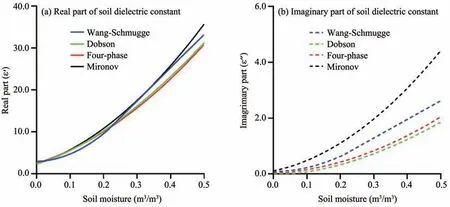
Figure 3 Simulation case at 1.4 GHz,the effect of soil moisture on dielectric constant under scenario(1)
In order to further analyze the effect of dielectric models' differences on the brightness temperature as soil moisture increased,this research adopted the average LAI=5.4 m3/m3obtained with three times of measurement in the field through the "quadrat" survey as the input parameter of vegetation parameterization scheme. Afterwards, the average LAI conducted the dual-polarized microwave brightness temperature simulation under scenario (1) as shown in Figure 4, under the same soil moisture conditions the simulated microwave brightness temperature results under different soil dielectric model conditions are significantly different. When the soil moisture is between 0.03 m3/m3and 0.23 m3/m3, the microwave brightness temperature of the Wang-Schmugge model is greater than the other three models. For the Dobson model, when the soil moisture is 0.13 m3/m3and 0.14 m3/m3, the difference of simulated horizontal and vertical polarization microwave brightness temperature of this model and the Wang-Schmugge model is 8.0 K and 4.4 K. When the soil moisture was greater than 0.23 m3/m3but not saturated,the microwave brightness temperature simulated by the Four-phase model was significantly greater than the other three models, while the result of the Mironov model was less than the other three models.The simulation difference between Four-phase model and Mironov model reached its maximum when the soil moisture was saturated, specifically, 6.1 K for horizontal polarization and 4.8 K for vertical polarization. Therefore, for the grassland underlying surface of Qinghai-Tibet Plateau, there were obvious differences in the microwave brightness temperature simulated by different soil dielectric models, and the horizontally polarized simulation was more sensitive to the soil dielectric model than the vertically polarized simulation.
Temperature was also one of the crucial factors affecting the soil dielectric constant. Figures 5a, 5b are the variation characteristics of the real and imaginary parts of soil dielectric constant in simulation case (2). For all four dielectric models, the real part and imaginary part generally displayed the same changing trend, but the real and imaginary parts of the Mironov model were less affected by temperature changes than the other three dielectric models.When the temperature was 298.0 K, the difference between the real part of the Wang-Schmugge model and that of the Mironov model reached a maximum of 1.3, while the maximum difference of the imaginary part appeared between the Mironov and Dobson models, which was 0.9.According to the analysis results of the effects of soil moisture and temperature on soil dielectric constant, the change of soil moisture affected the dielectric constant much more sharply than the change of soil temperature. Therefore, the microwave brightness temperature difference caused by the soil temperature in different models is not discussed in this study.
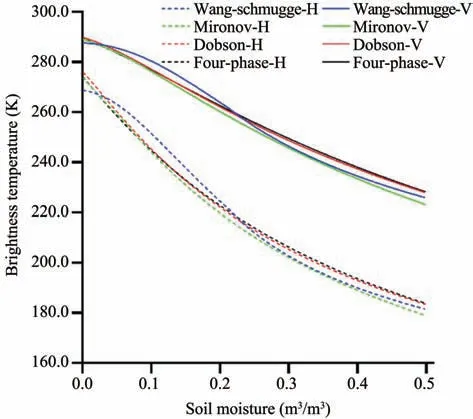
Figure 4 Simulation case at 1.4 GHz,the effect of dielectric models'differences on brightness temperature as soil moisture increased under scenario(1)
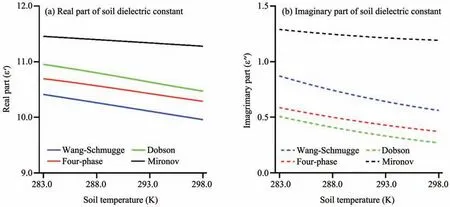
Figure 5 Simulation case at 1.4 GHz,the effect of thermodynamic temperature on dielectric constant under scenario(2)
4.2 Comparison between the observed microwave brightness temperature and simulated microwave brightness temperature
As an important part of theτ-ωmodel, the soil dielectric model directly affected the accuracy of microwave brightness temperature simulation and soil moisture retrieval. In order to further evaluate the effect of soil dielectric models' differences on microwave brightness temperature simulation under actual conditions, this research took the soil moisture observed at the depth of 2.0 cm as the reference moisture at the effective detection depth of L-band,and carried out the brightness temperature simulation of forward surface radiation. Figures 6a, 6b show the simulation results of microwave brightness temperature of each dielectric model. The changing trends of simulated and observed microwave brightness temperatures show high consistency (R2> 0.85, but the vertically polarized simulation generally overestimated the microwave brightness temperature (bias> 1.53 K), while all horizontally polarized simulations underestimated microwave brightness temperature (bias< -0.07 K). There was no obvious difference in correlation between observation results and simulation results of each soil dielectric model with both horizontal polarization and vertical polarization, but the statistical results of accuracy shows (presented in Figure 7) that no matter what kind of soil dielectric model was used,the errors(RMSE,ubRMSE) corresponding to the horizontally polarized microwave brightness temperature simulation were always greater than those of the vertically polarized microwave brightness temperature simulation. That was because the horizontally polarized microwave brightness temperature was more sensitive to surface roughness (Zhenget al., 2019). Compared with the other two soil dielectric models, bias of the Wang-Schmugge model with horizontal polarization showed the minimum value, which was 0.07 K, while the minimum bias with vertical polarization appeared in the Mironov model, which was 1.53 K, and the Four-phase model showed the smallest simulation errors (RMSE,ubRMSE) with horizontal polarization.In summary, in the microwave brightness temperature simulation, the results were greatly affected by the selection of different soil dielectric models.

Figure 6 The ELBARA-III observed brightness temperature at 50°incident angle and the simulated brightness temperature based on the four dielectric models

Figure 7 Statistics of microwave brightness temperature between simulation and observation with 50°horizontal and vertical polarization for different dielectric models
4.3 Evaluation on the results of soil moisture retrieval
Figures 8a, 8b are the results of soil moisture retrieval using four soil dielectric models based on the observed microwave brightness temperature with vertical and horizontal polarization, respectively. It shows that for all the soil dielectric models,compared with horizontal polarization, the soil moisture retrieved with vertically polarized microwave brightness temperature showed better consistency with the actual soil moisture at depths of 2.0 cm and 5.0 cm. The statistical results (Table 2 and Table 3) also show that the soil moisture retrieved by different soil dielectric models in the 2.0 cm depth (0.79≤R2≤0.85) is slightly better than in the 5.0 cm depth (0.76≤R2≤0.80). This is consistent with the latest research results of effective retrieval depth based on the L-band ground-based microwave radiometer (Escorihuelaet al., 2010; Royet al.,2017).As to the results of horizontally-polarized retrieval(Figure 8a),the statistical results in Table 2 indicates that for the typical grassland underlying surface on the Qinghai-Tibet Plateau with the same surface roughness and vegetation optical thickness, the four models'soil moisture retrieval all significantly underestimated the actual soil moisture(bias<-0.027).Specifically, the retrieval results of the Wang-Schmugge model showed better correlation with the observed soil moisture at 2 cm and 5 cm, and the three statistical parameters ofRMSE,ubRMSEandbiasalso shows that its retrieval result was slightly better than that of the other three soil dielectric models. According to the analysis of dielectric constant's effects on microwave brightness temperature simulation in section 4.1, the Wang-Schmugge model affected microwave brightness temperature differently under different conditions of soil moisture.When the soil moisture content was low,the simulated microwave brightness temperature was greater than that of the other three kinds of soil dielectric models. Therefore, for low soil moisture content and the same microwave brightness temperature, the Wang-Schmugge model could effectively reduce the underestimation of soil moisture retrieval with horizontally polarized microwave brightness temperature under the current parameterization scheme by improving the retrieved soil moisture. Therefore, the Wang-Schmugge model helped improve the accuracy of soil moisture retrieval with horizontally polarized microwave brightness temperature on the typical underlying surface of the Qinghai-Tibet Plateau.
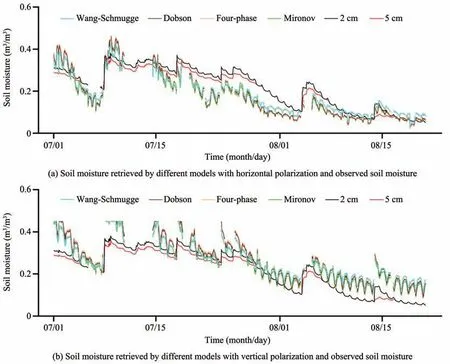
Figure 8 Time series of soil moisture retrieved based on four dielectric models and observed soil moisture at 2.0 and 5.0 cm depth

Table 2 Statistics of soil moisture between H-polarization retrieval and measurement at 2.0 and 5.0 cm for different dielectric models
As for the results of vertical polarization retrieval,Figure 8b shows that the results of all the four dielectric models were generally consistent with the observed soil moisture at two depths (R2≥0.79), but the errors were large (RMSE> 0.061 m3/m3). The Mironov model showed the best soil moisture retrieval results with vertical polarization (statistical parameters are presented in Table 3), where the bias between retrieved soil moisture and observed soil moisture was the smallest. On the other hand, in the Four-phase model, the bias between retrieval and observation was the biggest, which is consistent with the microwave brightness temperature simulation results using different soil dielectric models in section 4.1. This was because when the soil moisture was low,the two models had little effect on the microwave brightness temperature simulation,but when the soil moisture content was high, the microwave brightness temperature simulated by the Four-phase model was always greater than that of the Mironov model. But, for the same microwave brightness temperature, the soil moisture retrieved by the Four-phase model was greater than that of the Mironov model. In general, the Four-phase soil dielectric model enhanced the degree of retrieved soil moisture overestimating the observed soil moisture, while the Mironov model reduced such an overestimation.

Table 3 Statistics of soil moisture between V-polarization retrieval and measurement at 2.0 and 5.0 cm for different dielectric models
4.4 Regional distribution of soil moisture
Based on the microwave data of the FengYun-3C(FY-3C) satellite and the Wang-Schmugge model, theτ-ωradiation transmission model is used to retrieve the spatial distribution of the summer surface soil moisture in the study area. For more information about the FengYun satellite please reference Liuet al.(2019). Figure 9 shows that estimated soil moisture in summer (August 14, 2016) decreases from south to north. The regions of higher value are concentrated at the southeast of source region of the Yellow River,and its soil moisture values could reach more than 0.15 (cm3/cm3), while in the northwest and north regions,the values are less than 0.10 mm.
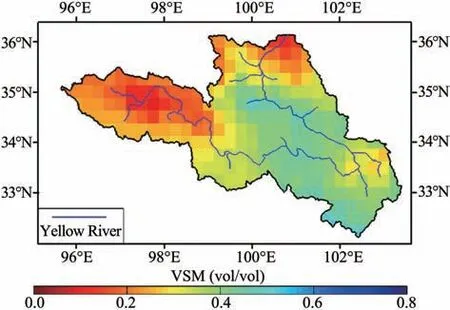
Figure 9 Regional distribution of soil moisture over the source region of the Yellow River in summer,2016
5 Conclusions
This study, based on theτ-ωradiative transfer model and with given vegetation optical thickness and surface roughness, has analyzed the effects of four soil dielectric models,i.e.,Wang-Schmugge,Mironov,Dobson, and Four-phase, on the soil moisture retrieval using L-band microwave brightness temperature on the alpine grassland underlying surface of the Qinghai-Tibet Plateau. The observation data used in the experiment was measured by the ground-based microwave radiometer (ELBARA-III type, L-band). The main conclusions are as follows:
(1) Results of the soil dielectric constant simulation show that during the non-frozen period, by comparison with the soil temperature,the soil moisture affected the soil dielectric constant much more greatly;and the forward microwave brightness temperature simulation with H-polarization was more sensitive to differences in the four soil dielectric models than V-polarization.
(2) Results of microwave brightness temperature simulation based on the forward model shows that there was no significant difference in the statistical correlation between the microwave brightness temperature simulated based on the four soil dielectric models and the observed microwave brightness temperature under the same polarization condition, but there were significant differences in the results of accuracy statistics. Therefore, the difference between soil dielectric models had a crucial effect on microwave brightness temperature simulation.
(3) As for the retrieval method used in this study,the comparative analysis of soil moisture retrieval results based on the four soil dielectric models shows that no matter which soil dielectric model was used,by comparison with H-polarization, the results of V-polarization soil moisture retrieval were more consistent with the observed soil moisture. More specifically, the Wang-Schmugge model can improve the accuracy of soil moisture retrieval under the horizontal polarization on the typical underlying surface of the Qinghai-Tibet Plateau; soil moisture from the Fourphase soil dielectric model was overestimated compared with the other three soil dielectric models,while the Mironov model can effectively reduce this overestimation.
(4)The higher value of soil moisture is concentrated at the southeast of source region of the Yellow River, and its soil moisture values could reach more than 0.15 (vol/vol), while in the northwest and north regions,the values are less than 0.10 mm.
Acknowledgments:
This work was supported by the National Science Foundation of China (Grant Nos. 42075065 and 91737103 and 41530529), the Second Tibetan Plateau Scientific Expedition and Research (STEP) program (Grant No.2019QZKK0105).
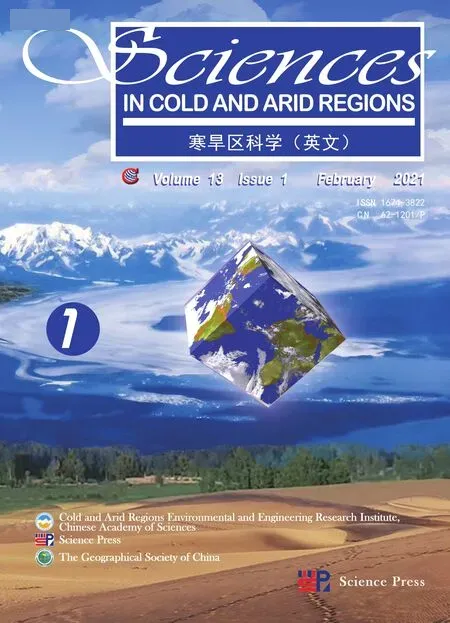 Sciences in Cold and Arid Regions2021年1期
Sciences in Cold and Arid Regions2021年1期
- Sciences in Cold and Arid Regions的其它文章
- Constitutive models and salt migration mechanisms of saline frozen soil and the-state-of-the-practice countermeasures in cold regions
- Simulated effect of soil freeze-thaw process on surface hydrologic and thermal fluxes in frozen ground region of the Northern Hemisphere
- Direct incorporation of paraffin wax as phase change material into mass concrete for temperature control:mechanical and thermal properties
- Response of revegetation to climate change with meso-and micro-scale remote sensing in an arid desert of China
- The evapotranspiration and environmental controls of typical underlying surfaces on the Qinghai-Tibetan Plateau
